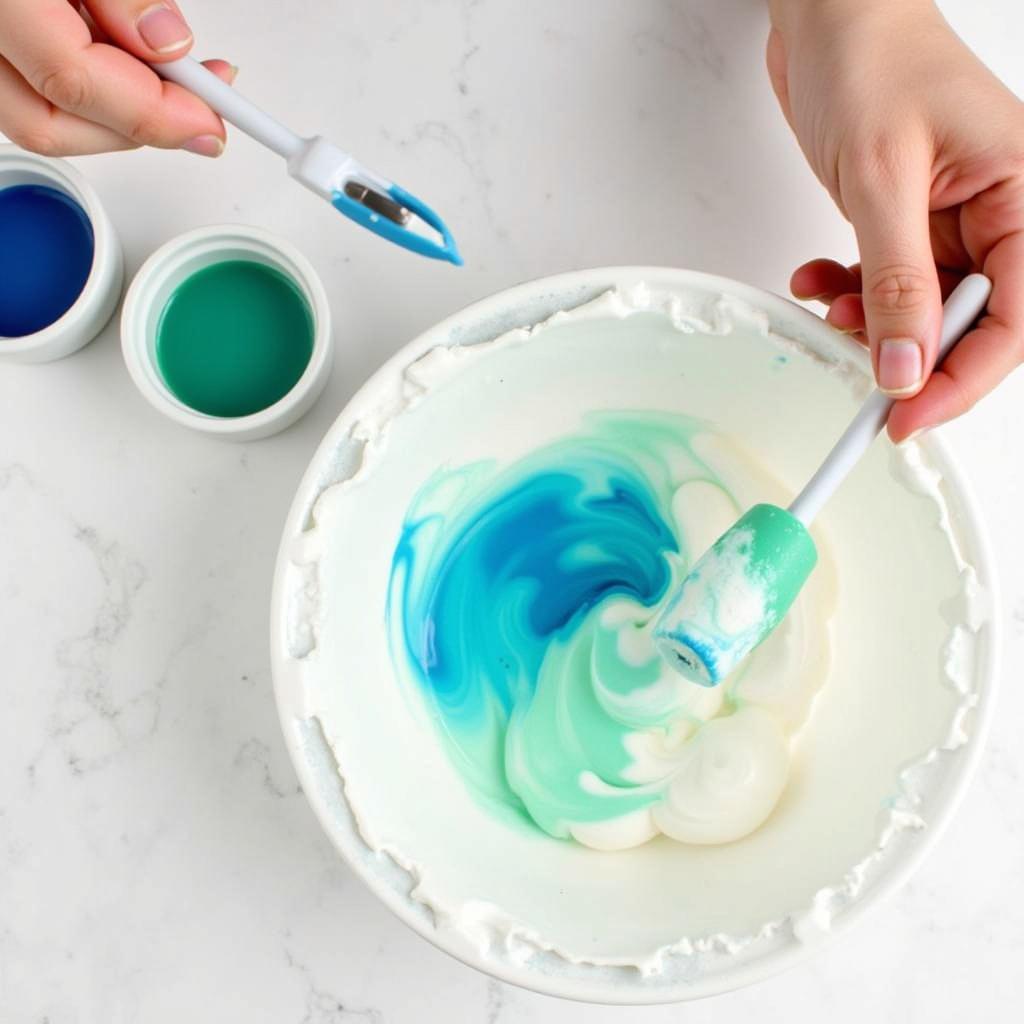Transforming a simple cake into a vibrant masterpiece often hinges on the frosting. Knowing How To Color Frosting effectively unlocks a world of creative possibilities, allowing you to personalize your desserts for any occasion. Whether you’re aiming for a pastel swirl or a bold statement, mastering the art of frosting coloration is a valuable skill for any baker.
Knowing how to color frosting opens up a whole world of decorating possibilities. From vibrant rainbows to subtle pastels, you have complete control. You can match your frosting to party themes, create intricate designs, or simply add a touch of personalized color. how to make pink frosting with food coloring offers a specific guide to achieving various shades of pink. From the softest blush to the brightest fuchsia, learning to control color intensity is key.
Essential Tools and Ingredients for Coloring Frosting
Before diving into the techniques, gathering the right tools and ingredients is crucial. This includes:
- Gel food coloring: This concentrated form offers vibrant hues without altering the frosting’s consistency.
- Liquid food coloring: A readily available option, but use sparingly as it can thin the frosting.
- Natural food coloring: Derived from fruits, vegetables, and spices, these offer subtle earth tones.
- Toothpicks or skewers: For adding color gradually and preventing over-saturation.
- Mixing bowls: Separate bowls for different colors to avoid cross-contamination.
- Spatulas or whisks: For thorough and even color distribution.
Mastering Different Coloring Methods
Using Gel Food Coloring
Gel food coloring is the preferred choice for achieving intense, vibrant colors without affecting the frosting’s texture. Start by adding a small amount of gel color to your frosting with a toothpick. Mix thoroughly until the color is evenly distributed. Gradually add more color until you reach your desired shade.
Utilizing Liquid Food Coloring
While liquid food coloring is more common, it can thin your frosting. Add it drop by drop, mixing well after each addition. Be patient and add color slowly to avoid making your frosting too runny. If the frosting becomes too thin, add more powdered sugar to adjust the consistency. For specific color guides, how to make turquoise color frosting provides step-by-step instructions for achieving that vibrant shade.
Exploring Natural Food Coloring Options
For a more natural approach, explore options like beet juice for pink, turmeric for yellow, and spinach for green. Keep in mind that natural colors are often less vibrant and may slightly alter the frosting’s flavor. If you’re seeking natural alternatives, how to color frosting without food coloring offers a deeper dive into various techniques and ingredients.
Creating Specific Frosting Colors
Achieving a Perfect Teal
To achieve a stunning teal, combine blue and green gel food coloring. Start with a base of white frosting and add small amounts of each color, mixing thoroughly until you reach the desired teal shade. You might find helpful information at how to make teal colored frosting.
 Mixing Blue and Green Gel Food Coloring to Make Teal Frosting
Mixing Blue and Green Gel Food Coloring to Make Teal Frosting
Making Orange Frosting Without Food Coloring
Creating orange frosting without artificial coloring involves using natural ingredients. A combination of carrot juice and a touch of turmeric can yield a beautiful, natural orange hue. For a more detailed guide, check out how to make orange frosting without food coloring.
Tips for Success
- Always start with a small amount of coloring and gradually add more until you achieve your desired shade.
- For consistent results, use a color chart or keep track of the amount of coloring used for each batch.
- If your frosting becomes too thin after adding liquid coloring, add more powdered sugar to thicken it.
- Store colored frosting in airtight containers at room temperature or in the refrigerator, depending on the type of frosting.
“The key to vibrant frosting is using high-quality gel food coloring and adding it gradually,” advises renowned pastry chef, Amelia Dubois. “This ensures even distribution and prevents over-saturation.”
Conclusion
Learning how to color frosting effectively allows you to transform your baked creations into personalized works of art. By understanding the different coloring methods and following these tips, you can achieve any shade imaginable and elevate your desserts to the next level. So, grab your coloring tools and start experimenting with a world of vibrant possibilities!
FAQ
- What type of food coloring is best for frosting?
- How do I prevent my frosting from becoming too runny when using liquid food coloring?
- Can I use natural food coloring for frosting?
- How do I achieve specific colors like teal or orange?
- How do I store colored frosting?
- How can I make pastel shades of frosting?
- What if I add too much food coloring to my frosting?
“Remember to always test your colors on a small amount of frosting first,” adds cake decorator extraordinaire, Julian Vance. “This allows you to adjust the shade before committing to the entire batch.”
Call us at 0373298888, email us at [email protected] or visit us at 86 Cau Giay, Hanoi. We have a 24/7 customer service team.

